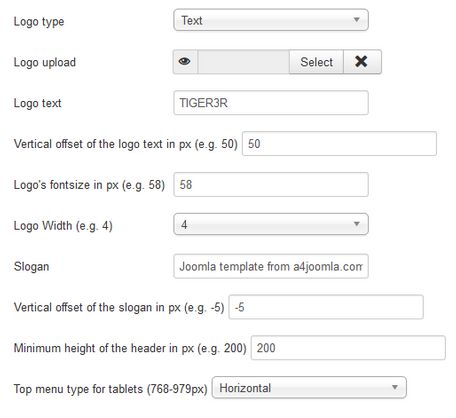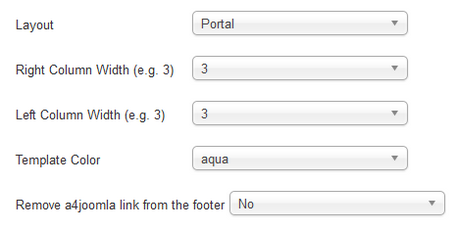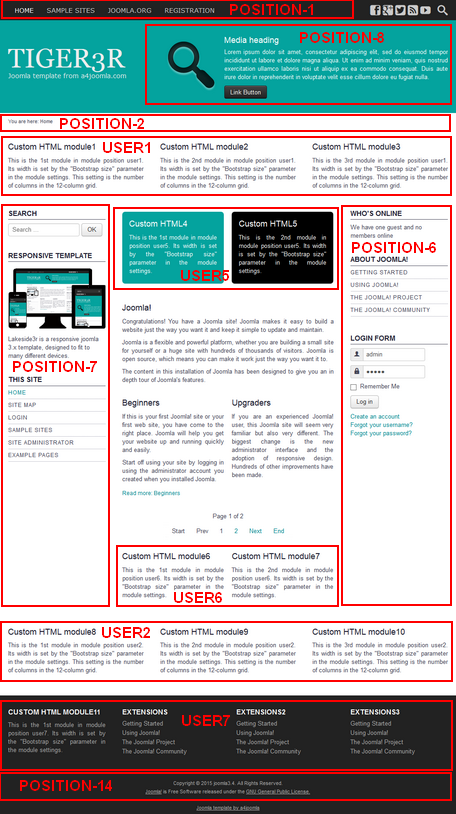The main features and settings of this joomla template are:
- joomla 3.x template
- you can see the demo site here
- based on the Bootstrap framework
- cross-browser compatible
- responsive template (also fits to mobile devices)
- 12-column grid system
- dropdown menu
- portal or blog layout
- 15 social icons
- 5 color schemes
- 2 module styles
- 11 module positions
- several customizable features, see the template parameters below
Template parameters
After template installation and choosing it to the default template, click on the template's name in the template manager to set the parameters shown below.
The template uses a 12-column grid, so the Logo width, the Right column width, and the Left column width are the number of columns in the 12 column grid. You may have to play with these settings. Always check how the site looks when you decrease the browser window size, because the template is responsive, and the look of the site changes with the browser (or display) size.
For tablet devices you can choose between the mobile topmenu and the horizontal dropdown topmenu. The latter may not be handled well on some tablet devices. But the horizontal menu can also be good for tablets if there are no submenu items.
The social and search icons will be displayed only if you type some URL for their parameters. You have to set up a search page, and put its URL to the search page parameter to have a search icon. To make a search page, create a new hidden menu, that has no published module, then create a new search menu item, save it, and copy its alias to the end of the site URL to see the search page.



Module positions
The following module positions exist in this template:

Header module
You can put a custom HTML module, or e.g. a 3rd party slideshow module into the position-8 module position. But if you would like a similar arrangement of an image, text, and a button as above, you can use the following code in a Custom HTML module:
<div class="media">
<a class="pull-left" href="#">
<img src="/images/search.png" alt="" />
</a>
<div class="media-body">
<h2 class="media-heading">Your title</h2>
Your text is here.... <br />
<a class="btn btn-inverse" style="margin-top: 10px;" href="#">Link Button</a>
</div>
</div>
Top menu (dropdown menu) settings:
In position-1 you can setup a dropdown menu, just set the "Menu class suffix" to (space)nav-dropdown and remove everything from the "Module class suffix" of this module in the module manager! Also set the "Show submenu items" to "Yes"! Mouse over the Parameters menu item above to see that the horizontal line in the submenu is a "text separator" menu item, the Color schemes is a "Menu heading" menu item.
Side menu style
If you want a side menu that looks like the menus on the demo, set the "Module class suffix" to _menu and remove everything from the "Menu class suffix"! If you also want to hide it from mobile phones, set it this way:
Module class suffix:_menu hidden-phone
Menus in the user7 position
You can style the menu without bullets and separators in user7, if you set the "Module class suffix" to _menu2 and remove everything from the "Menu class suffix" in the module settings.
Login module
Set the "Display Labels" to "text" in the module settings, because the other setting is not cross-browser compatible.
USER1,2,5,6,7 positions
You can set the module widths in the user1,2,5,6,7 positions by setting the "Bootstrap size" parameter in the module settings. The sum of the module widths in a module position should be 12, because a 12-column grid is used in this template.
Light and dark module styles
You can set a light or dark background for the modules in the position-6,7, user1,2,5,6 module positions by setting (space)light or (space)dark "Module class suffix" in the module settings.
Mobile devices
This template is responsive, so it adapts to the size of the mobile device. On the demo site you can also see this on a desktop computer when you decrease the size of your browser. But it's worth hiding some of the modules on mobiles, because the order of the content of the website corresponds to the order of that in the source code. For this purpose you can use some css classes for the modules in the "Module class suffix". E.g. type
(space)hidden-phone
into the "Module class suffix" if you want to hide a module from mobile phones. You can read more about this topic if you click here.
CSS modifications
From template version 3.5, you can put your own CSS code into the css/user.css file that you have to create if you need it.
Less files
If you want to use the less files, don't use the Less compiler joomla plugin, because I found it buggy. I rather used the Winless software, but the main point is to use something that uses the original less.js.
